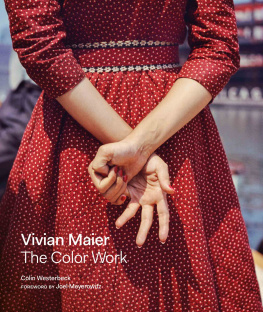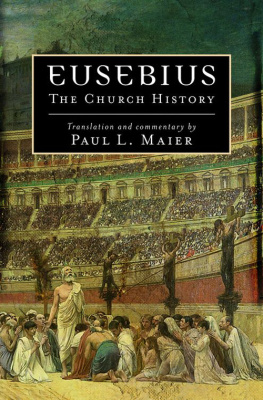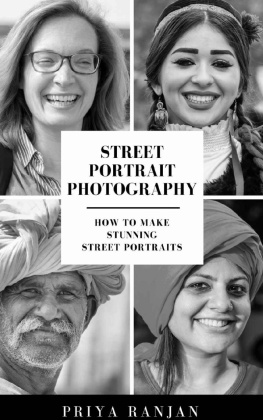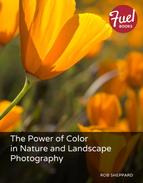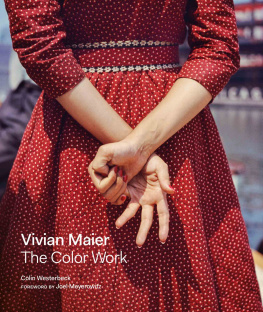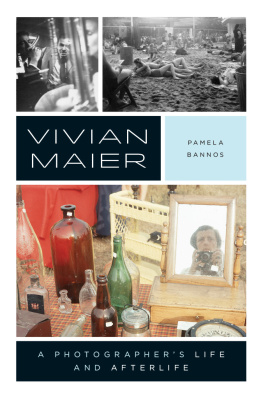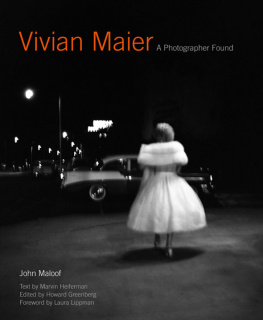Contents

Self-portrait, location and date unknown.

Self-portrait, location unknown, 1956.

Chicago, 1962.
One of photographys truths is that the best street photographers learn to be invisible or, at the very least, to convince themselves that they are. Over the years, Ive walked the streets with Henri Cartier-Bresson, Garry Winogrand, Tony Ray-Jones, Diane Arbus, Lee Friedlander, Tod Papageorge, and some of todays younger shootersGus Powell, Melanie Einzig, Ben Ingham, and Matt Stuartand we have all developed our own sleight-of-hand street act. We dodge, feint, twirl, two-step, and eye-shift our way through crowds and rallies, along avenues and backstreets, in parks and on beaches, anywhere that ordinary life draws our attention and desire. It is our invisibility that helps us get away with stealing fire from the gods.
In 2009, into the well-established history of street photography flashed the unexpected comet of Vivian Maier. In October of that year I received an email from John Maloof, a young artist I didnt know. He introduced himself and told me the story of how he had purchased a cache of negatives, slides, and some prints at a storage-warehouse auction. Knowing my work, as well as Bystander: The History of Street Photography, a book I coauthored with Colin Westerbeck, he had decided to write to ask whether I would be kind enough to give him my opinion on Maiers photographs.
Attached to the email were about two hundred color slides made between the late 1950s and mid- 1970s, all of which John had scanned. I cant say that my immediate first impression was that they were fantastic, but as I clicked through the unedited raw work I kept getting glimpses of Maiers insights and timing; great, positive attitude; way of framing; courage of her convictions about how close she was willing to go; genuine curiosity; and undeniable, humanistic warmth, irony, and humor, all of which produced an overall sense of a coherent life view. After looking at all the images, I had that delightful sense that comes from seeing inspiring and intelligent work. I went back through the slides, cut them down to forty or fifty, and looked at them again.
Now I could really see the heart in the work. Who was this woman? Was she simply a naf who sprang whole into midcentury American photography, or had she done her fair share of looking at other work? Before writing back to John, I wrote to Colin: You have to see this workan unknown woman just landed in the middle of the history of street photography. There were tender portraits and exquisite moments of frozen action; there were streetscapes and children at play; there were small details and gestures beautifully seen and framed, as well as photographs of the old, the down-and-out, and the lost souls of Chicago and New York. Above all, there was a fierce intelligence weaving its way throughout the color work. All this, in color! How courageous, and how invisible! I was sure she didnt print color, because... who did back then? Which meant that the photographs had stayed hidden in boxes and most likely hadnt played a big role in her artistic growth, yet they wereand are nowworks of value to us who are alive to see her development.
Look closely at the many self-portraits Vivian Maier made, and you will see her disguises, her cloak of invisibility. Shes as plain as an old-fashioned schoolmarm. Shes the wallflower, the spinster aunt, the ungainly tourist in the big city... except... she isnt! She was a professional nanny, which is a great disguise in itselfbecause how suspicious or dangerous could a woman shepherding a couple of kids possibly be? Her line of work gave her license to be out on the streets, making any image she was interested in. You can see in her photographs that she was a quick study of human behavior, of the unfolding moment, the flash of a gesture, or the mood of a facial expressionbrief events that turned the quotidian life of the street into a revelation for her.
However, my sense is that Maier preferred to shoot, and made stronger work, in black-and-white for several reasons. Black-and-white was a faster film to work with, as opposed to early Kodachrome, which was extremely slow and therefore riskier. With black-and-white, she could have prints to hold in her hand and reflect upon, which would put her more in harmony with her instincts. Her heart for the game of sight, the strength and purity of her instinct, and her deep love of photography show up more consistently in black-and-white. It was in this medium that she learned to stand her ground, to move in close to cops and drunks, punks and wise guys, and the old and infirm, yet stay connected and maintain her sense of humor in difficult situations.
But there are memorable gems in Maiers color work, and some terrific observations and characters are to be found in this book. You can see again and again the way color could entice her when a color incident emerged out of the flux of daily life. Take, for example, the simple image shown on the cover of this book of a hand holding a pinkie, folded on a red dress in a strangely affecting gesture behind a womans backan image as powerful as a nations flag.
Maier was an early poet of color photography.
Joel Meyerowitz
We dance around in a ring and suppose,
But the Secret sits in the middle and knows.
Robert Frost, The Secret Sits, 1936
Robert Frosts poem The Secret Sits should have been chiseled on Vivian Maiers tombstone. Im the mystery woman, Maier once told some children she tended during her long career as a nanny. She was indeed the mystery woman, and remained so until a couple of years after she died. When an artists fame arrives only postmortem, it puts a special burden on the work itself to tell us who he or she wasespecially in this case, when all we have, besides around 140,000 negatives and positives, are the scattered reminiscences of a few people who were not, themselves, in the art world. The one other photographer who immediately comes to mind as having had such posthumous fame, Eugne Atget, is more intimidating than encouraging. Atget was a failed actor who supported himself by making documents for artists, as the sign outside his Paris atelier read. Though he died in relative obscurity, his photographic documentation of the city in the early twentieth century is now considered one of the great masterworks in the mediums history. But before determining whether Maiers work merits a place in that pantheon, lets first examine a different art-world context into which her career might fit by analogy.
Two years after World War II ended, three photographersHenri Cartier-Bresson, Robert Capa, and David Seymour, who worked under the byline Chimestablished an invitation-only cooperative for photojournalists, which they called Magnum. The emphasis was not on the star power of the photographers but rather on maintaining a certain quality of work, no matter which member came up in the rotation. Cartier-Bresson was successful at keeping the publics eye on his photographs rather than his personal life. But Capa, whose death-defying coverage of war and movie-star good looks made him a romantic figure anyway, died in 1954 while photographing in Indochina, after which his life became the sort of legend that often reduced his photographs to mere illustration of his myth.
In 1967, twenty years after the founding of Magnum, another triumvirate of photographers emerged in
Next page
